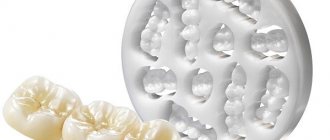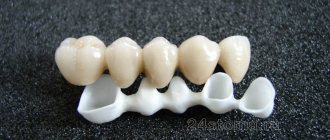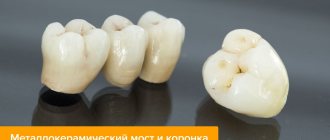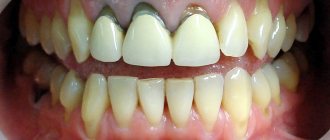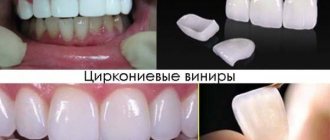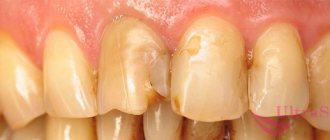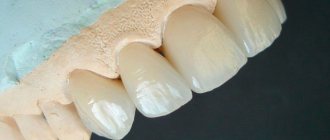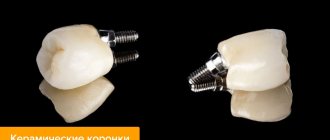Without exaggeration, zirconium crowns are a universal and technologically advanced orthopedic design. Strength and durability, like metal. And the aesthetics are like ceramic dentures. At the same time, dental crowns are comfortable and safe to wear, do not cause allergies, and do not harm the body.
In addition, a zirconium dioxide prosthesis can be installed on any dental unit - in the front row, on molars and premolars. The design is also suitable for fixing bridges of 2-3 teeth. Service life with proper use is from 10 to 15 years. Now more details.
Peculiarities
Modern prostheses are made from natural stone, zircon, which is white. Externally, the material resembles real teeth, and in terms of hardness and strength it is often compared to metal. Like everything natural, zirconium dioxide crowns are completely compatible with the human body, take root well and do not cause discomfort when worn constantly. Unlike metal ceramics, a zirconium prosthesis does not cause darkening of the gums, galvanism, and is suitable for people with high sensitivity to foreign materials.
The prosthesis is made using CAD/CAM computer technology - a painstaking and complex process that requires highly qualified doctors and dentists. This explains the high cost of the orthopedic design.
But if you look at the characteristics of zirconium crowns, it becomes clear that the investment is completely justified:
- The strength of the material is 2.5 times higher than that of ceramics (900-1000 MPa).
- The automated manufacturing process reduces the risk of errors, unlike manual production. The technology is so precise that often after installing crowns, additional grinding and turning of the prosthesis is not required.
- The aesthetic properties of a zircon prosthesis are slightly worse than porcelain crowns. They have lower capacity (less transparent). However, from the outside, it is difficult even for a specialist to distinguish zirconium crowns from real natural teeth.
How teeth are treated for zirconium and metal-ceramic crowns
Before installing a zirconium crown or other types of artificial crowns, the teeth must first be prepared.
Turning for a zirconium crown
If we talk about zirconium crowns, then due to the zirconium dioxide in their base, the alloy is initially light in color, then for coating with ceramics, it does not need to be further masked by covering with special ceramic primer materials.
Due to this, the thickness of zirconium crowns can be less than the thickness of metal-ceramic crowns based on noble and base metals; accordingly, the degree of tooth processing for such a crown, grinding, will be less.
It is often possible to prepare teeth for zirconium crowns without first removing the nerves from them, of course, taking into account all medical indications and the condition of each specific tooth, but often crowns can be placed on living teeth.
Preparing a tooth for a metal-ceramic crown
If we are talking about metal-ceramic crowns, then due to the thickness of the crown, which contains a metal alloy, which still needs to be aesthetically closed so that it does not show through, and covered with ceramics, due to a certain number of layers of ceramics, a more vibrant appearance corresponding to the teeth is given.
The thickness of metal-ceramic crowns turns out to be greater, and often when preparing teeth for such crowns, it is necessary to remove the nerves of the teeth, in order to depulpate the teeth, so that there are no complications in the future if the tooth under such a crown hurts due to inflammation of the nerve.
Teeth from which the nerves have already been removed are, by default, less durable than living teeth.
Although, in certain situations, it is sometimes necessary to depulpate teeth under both types of crowns, this depends on medical indications, contraindications to depulpation, and removal of nerves from teeth.
Varieties
The issue of aesthetics helps to decide the type of design and manufacturing method. There are classic and monolithic types of crowns.
In the first case, a zirconium base is used as a frame. And ceramics are applied on top in several layers. Thus, the design perfectly combines the strength of zircon and the impeccable aesthetics of ceramics.
Monolithic crowns are made from a single block, without additional cladding. But the mineral in its “pure form” has a milky tint, and differs from natural teeth. Therefore, monolithic zirconium crowns are used to restore chewing teeth.
The second type of prosthesis is more reliable, because eliminates possible chips on metal-free ceramics. To improve aesthetics, manufacturers began to produce colored zircon blocks (for example, Prettau technology). These crowns can be used to restore teeth in the smile area.
There is a material similar in external properties to zirconium dioxide - aluminum oxide. But the design is less durable, so it is used less often and only for prosthetics of the front teeth.
Zirconium crowns: before and after photos
Below we have given successful examples of prosthetics for front teeth with zirconium crowns. However, to be objective, not all patients will achieve such an aesthetic result (as in Fig. 12-19). Below in the article we will also show unsuccessful examples of zirconium crowns on the front teeth.
Clinical case No. 2 –
Clinical case No. 3 –
Clinical case No. 4 –
Advantages of zirconium dioxide crowns
The popularity of zirconium crowns is due to many advantages.
The main thing is strength, which we have already talked about. Let us only add that the reliability of the prosthesis is confirmed by its use in complex bridge structures. The material is also used for prosthetics of the entire jaw, with complete or partial edentia. The second argument in favor of zircon is minimal grinding of the tooth when installing a prosthesis. The thickness of the crown is not at all large, so no more than 0.3-0.5 mm of enamel is removed from the supporting tooth. If the tooth is healthy and the pulp is not inflamed, then the dental nerve remains inside the tooth. This allows you to save your natural tooth for the maximum period, even if it is severely damaged.
Interestingly, throughout the entire period of use, zirconium dioxide crowns retain their external qualities. The surface of the prosthesis does not darken and is not subject to pigmentation. Zircon is also resistant to temperature changes, so the patient does not have a reaction to hot or cold food.
Making a prosthesis using digital technology ensures a tight fit of the internal cavity of the artificial tooth to the stump. This prevents the dental cement on which the prosthesis is attached from being washed out. As well as food getting and getting stuck inside the structure.
Zirconium fixation: basic and new concepts
Tags: Fixation of restorations Metal-free Veneers
Deca-methacryloyloxydecyl dihydrogen phosphate is something of a buzzword for those who are not chemists by trade, so in everyday life this adhesive monomer is simply referred to as MDP (an acronym formed using the initial three letters). This chemical agent was developed by Kuraray Noritake Dental in 1981 to improve the adhesion strength of hydroxyapatite, and has been indispensable in dentistry ever since. Fixation of zirconium restorations, by the way, is also impossible without MDP monomer.
Requirements for indirect restorations
Indirect restorations in modern dentistry must meet at least three requirements. First of all, they must ensure the preservation of tooth tissue. For any crown, as a rule, it is necessary to sacrifice approximately 70% of the enamel and dentin, and the feasibility of such a sacrifice can only be justified if a reliable prognosis for the functioning of the restoration is ensured. However, given that adhesive protocols are moving forward at tremendous speed, the amount of hard tissue reduction required today can be significantly reduced without compromising the reliability of the connection. In such cases, zirconium restorations can be used. The latter involve both sandblasting and the application of MDP adhesive monomer.
Durability is the second requirement for indirect restorations. This property of the restoration is largely related to the flexural strength parameters of the material used. And although zirconium is a fairly reliable material, the prognosis for its functioning is also significantly influenced by the method of fixing the restoration to the tooth. Last but not least important criterion is the aesthetic parameter of rehabilitation. From this point of view, metal-ceramic crowns are already a thing of the past, and all-ceramic structures are the gold standard today. The reputation of zirconium from an aesthetic point of view was somewhat “tarnished” by the excessive whiteness of the representatives of the first generations of this material. Now zirconium dioxide is available in different shades and there are even multi-layer types (KATANA Zirconia ML, STML and UTML, all Kuraray Noritake) that provide the desired aesthetic result. Zirconium sintering remains a possible veneering option and is the most commonly used. A multilayer restoration helps to achieve different shades of transparency in the area of the incisal edge of the structure and its opacity in the cervical area: thus, light passes through the incisal part of the restoration, but is blocked at the neck of the tooth. Materials such as KATANA Zirconia ML also make it possible to maximally imitate natural tissues in the area of the body of the restoration, optimizing the process of their selection: for example, when restoring the neck with body shade A1, the transparency of this increases to the area of the incisal edge by exactly two transition shades.
Photo 1. KATANA Zirconia UTML
Photo 2. KATANA Zirconia STML
Photo 3. KATANA Zirconia ML
Photo 4: The veneers were made from KATANA Zirconia UTML and stained using CERABIEN ZR external stain (Kuraray Noritake).
Surface
Using the example of Daniele Rondoni from Savona (Italy), one can trace how the world of dental technicians is changing when using zirconium materials instead of their ceramic counterparts. According to the Rondoni philosophy, the initial selection of restorative materials should be wide enough to allow specific individual solutions to be realized, while the use of ceramics can be combined with lithium disilicate or zirconia copings, which helps to maximize the effect of a natural imitation of the restoration. Using sintered ceramic, the technician can modify the texture of the restoration to give it age-appropriate parameters. Regarding the surface structure, thorough polishing of the occlusal surface is the best prevention of abrasion of antagonist teeth and helps maintain optimal occlusal balance. Thus, the hardness of the material fades into the background, and the first is occupied by the parameters of smoothness and resistance of the material.
Flexural strength
When choosing a material for restorations, the dental technician will choose the multi-layer version of KATANA Zirconia Ultra Translucent Multi-Layered (UTML) for veneers or crowns in the anterior area. The transparency of this zirconium sample is comparable to that of glass.
This aspect is extremely important for the restoration of incisors and canines of both jaws. A crown made of KATANA Zirconia UTML harmonizes perfectly with adjacent natural teeth also due to the fact that this type of material is not excessively white. The second generation zirconium dioxide aesthetic material is sintered at a temperature of 1550° C, this temperature is maintained for 2 hours. The dental technician must be aware of the difference in the above mentioned temperature and setting for KATANA Zirconia High Translucent Multi-Layered at 1500 °C.
For larger bridgework, it is the last mentioned zirconium material that should be used, as KATANA Zirconia Super Translucent Multi-Layer (STML) is designed for the production of prosthetic structures up to a length of 4 tooth units. KATANA Zirconia UTML can be used for small anterior fixed prostheses, but is more suitable for single bridges and veneers.
The reason for this narrow application is that the flexural strength of these highly aesthetic zirconia materials is lower than that of standard zirconia - 1125 MPa, which is suitable for the manufacture of fairly large prosthetic elements. The flexural strength of highly esthetic zirconia varieties (approximately 750 MPa [STML] and 550 MPa [UTML]) is sufficient to ensure long-term performance of single esthetic restorations and limited span bridges.
Preparation
Flexural strength is not the only decisive factor in ensuring the functional reliability of restorations; other properties of the material are also of great importance, as are the specific stages of preparation for fixation of restorations. The preparation of teeth should be carried out with the formation of a champ, without any sharp edges and deep shoulder-type ledges. Obviously, it is also advisable to avoid any kind of undercutting. Since the restorations are fixed adhesively, it is recommended to avoid the presence of preparation channels, and all edges should be carefully rounded. When preparing for a full crown, it is necessary to ensure that the height of tissue reduction on the palatal and vestibular sides is strictly the same. When preparing for veneers, the amount of enamel reduction in the area of the incisal edge and neck should not exceed 0.4-0.8 mm, and on the labile side - no more than 0.5 mm. For inlays, it is enough to remove about 1 mm of tissue thickness, and when making full crowns, a similar space parameter should be provided on the lateral sides of the restoration.
Minimum wall thickness for restorations made of KATANA material
Maintain a pressed porcelain thickness of 0.8 mm in all areas of the tooth. When finishing a zirconium frame, its thickness must be at least 0.4 mm.
Fixation
Many options and modifications have been proposed for fixing zirconium structures. According to Professor Matthias Kern from the University of Kiel in Germany, further research in this area is generally no longer justified. As a scientist and practitioner, Kern has been involved in the development of the zirconia cementation protocol for the past 20 years. Based on his extensive experience, the scientist is convinced that in order to achieve reliable cementation of zirconium dioxide, three basic requirements must be met: firstly, fixation without a rubber dam is not fixation; secondly, the need to achieve micromechanical retention by sandblasting; thirdly, the need to ensure chemical communication. Based on extensive research, Kern is convinced that chemical adhesion can only be achieved using MDP monomer. His first publication on this topic dates back to 1998, and described his experience using PANAVIA (Kuraray Noritake), containing MDP monomer, to ensure adhesion of zirconia after sandblasting restorations.
Sandblasting
Dentists and dental technicians are trying to find an alternative to sandblasting zirconium, but attempts at such research remain only attempts. It was proposed to attach a layer of silica to the zirconia, which would strengthen the bond of the restoration, but, according to Kern, these and similar innovations such as the Rocatec method were unsuccessful. Silanization of zirconium is also ineffective because the material does not react with silane. Therefore, sandblasting is indispensable. The latter can be carried out in a small chamber, providing a slight air pressure of 0.5 bar for a soft type of abrasion, and 2.5 bar for a hard one. However, the pressure parameter is not key. Kern recommends sandblasting at 1 bar pressure to ensure proper surface roughness. It is obvious that the outer part of the restoration should be protected as much as possible from the influence of abrasive particles. It is also worth applying a dye (waterproof marker) to the surface being treated, which begins to disappear during sandblasting, providing more complete control over the abrasion process.
Photo 5: Low pressure sandblasting of zirconium oxide is essential for effective adhesion.
Adhesive monomer
After sandblasting the surface of the restoration, it can be cleaned using alcohol, although this step is optional. If alcohol is contaminated with saliva residues, its effect can be considered zero. However, the key is to ensure that the zirconium is fixed using a material containing MDP monomer. The latter is absent in glass ionomer cements, which are also sometimes used for cementing esthetic restorations due to their ease of use. Kern does not recommend the use of such materials. Research results indicate that composite cements containing MDP monomer provide the most long-term results in the functioning of zirconium structures. The oldest known cement in this category is PANAVIA EX, which was introduced to the market back in 1983. The optimized version of PANAVIA V5 was recently introduced into practice as the only cement that can be used absolutely for all types of cementation. All cements and bonding agents manufactured by Kuraray Noritake contain MDP monomer.
It is somewhat ironic that Kern, conducting its research in the state of Maryland in the USA for two years, recorded remarkable results in the functioning of Maryland-type adhesive bridges after appropriate processing and bonding. It has also been found that the retention of such structures is more durable when using a restoration design with only one retaining wing. For example, if an adhesive zirconia bridge with one retention wing is cemented using cement containing MDP monomer to replace, for example, an upper lateral incisor, the favorable prognosis for such a design can be up to 20 years. The success rate of such restorations over 5 years is 95.2%; similar results are typical for classic zirconium bridge structures.
Thus, sandblasting and the use of MDP monomer are mandatory steps to ensure strong adhesion of zirconia restorations. In addition, the MDP agent itself is an extremely long-lasting chemical that enhances the results of prosthetic rehabilitation for patients.
Source: stomatologclub.ru
Similar articles:
Aki Linden
Digital smile design and CAD/CAM technologies: production of provisional reproductions and final restorations
Cancellation
Treatment planning and smile design are integral stages of comprehensive rehabilitation in aesthetic dentistry.
Aki Linden Read
Paulo Monteiro
Five Meanings of Adhesive Rehabilitation (Part 1)
Cancel
We've been hearing a lot about minimally invasive rehabilitation lately, and when it comes to front teeth, we sometimes recommend minimal-thickness porcelain veneers.
Paulo Monteiro Read
Mger Markaryan
Phantom E-max
Cancel
Layer-by-layer application of metal-free ceramics E-max.
Mger Markaryan Read Jordi Manauta
Semi-direct veneers
Cancel
Additive restorations are the state-of-the-art solution for most clinical cases. A “no preparation”, “no bevel” approach should be used whenever possible, creating restorations that are reversible if desired.
Jordi Manauta Read
Ajay Juneja
Veneer prosthetic techniques: minimally invasive and non-invasive
Cancellation
Today, more than 20 years have passed since doctors began using veneers, the prosthetics of which do not require preliminary preparation.
Ajay Juneja Read
Jan Kurtz-Hoffmann
Complete restoration with IPS e.max
Cancellation
Long-term results in dentistry can only be achieved by using conceptually thought-out technology. Conceptuality can be thought of as the adherence to or development of basic concepts.
Jan Kurtz-Hoffmann Read Carlos Fernandez Villares
Integration of veneers: predictable results
Cancellation
Ceramic veneers in dentistry can solve a number of aesthetic and non-aesthetic problems that arise during orthodontic treatment or complement it.
Carlos Fernandez Villares Read Ajay Juneja
Ceramic veneers with tooth root coverage
Cancellation
This article presents 3 clinical cases in which various methods are proposed to achieve adhesion of veneers to dentin and the tooth root.
Ajay Juneja Read Ajay Juneja
Ceramic veneers: gentle preparation of tooth enamel
Cancel
This article provides step-by-step preparation instructions aimed at maximizing the preservation of tooth structure.
Ajay Juneja Read Francesca Vailati
Composite palatal veneers for restoring teeth with severe wear
Cancellation
A 46-year-old patient came to the Dental School of the University of Geneva with the main complaint that “his teeth were deteriorating at an enormous rate,” and finally he wanted to do something about it.
Francesca Vailati Read Kirill Kostin
Use of various digital tools in the planning and implementation of esthetic ceramic restorations. Skyn concept. Clinical case. Part 1
Cancel
This article presents a case study of the use of the concept and various digital tools for the planning and creation of all-ceramic CAD-CAM restorations.
Kirill Kostin Read
Maksimov Sergey
Empress -> E.Max
Cancel
Replacement of leaking Empress ceramic inlays
Maksimov Sergey Read
- ‹
- 1
- …
Cons of zirconium crowns
Prostheses made of zirconium are considered the most expensive among their analogues, in terms of the cost of material and manufacturing methods. In addition, the ceramic layer in the classic design of zirconium crowns is less durable. Chips may appear on the surface of the tooth, and the structure will have to be repaired or replaced.
The imperfection of aesthetics also falls into the “cons” column. Monolithic zirconium cannot convey the natural translucency of tooth enamel, so with a single tooth replacement it may look unnaturally white. However, if you restore the entire front row, there will be no problems with aesthetics.
Due to its strength, the material can wear away the enamel of neighboring teeth. The degree of abrasion is insignificant, but it is necessary to visit an orthopedic dentist periodically, once every six months, to prevent the destruction of healthy teeth.
Benefits of zirconium dioxide, in what cases is it used?
- Requires minor grinding (1 mm), which helps preserve the pulp. The tooth remains alive and does not decay further.
- Does not cause a reaction upon contact with saliva. The gums will not become inflamed or turn blue.
- Compatible with living tissues. Rejection does not occur, soft tissues do not change color.
- Originally white. Even if the gums sag, a cosmetic defect will not occur.
- Lasting. The risk of chipping is minimal. If this happens, just polish the surface.
- Has variable density. It increases from the cutting edge to the base. Therefore, the opposite tooth does not suffer.
Production process
As mentioned above, zirconium dental crowns are made using CAD/CAM computer technology. The first part of the abbreviation stands for computer modeling of prostheses. And CAM is the subsequent milling of crowns according to the developed three-dimensional model.
In other words, “manual” intervention in the process is minimized. This eliminates possible errors in the production of the structure associated with the human factor.
The prosthesis manufacturing process consists of several stages:
- To transfer data to the program, the dentist scans the oral cavity with a special scanner. This is done immediately after treating the supporting teeth.
- The program develops a virtual model of the jaw with a new prosthesis. At the same time, the doctor selects the shade for the crown according to the Vita scale.
- Based on the calculations, a three-dimensional model of the prosthesis is created, according to which a zirconium dioxide crown will be made using a milling cutter.
- The finished product is subjected to heat treatment. If the prosthesis is two-layer, then the zirconium dioxide base is “baked” first, and then a second time after lining with ceramics.
At the final stage, the dentist paints the crown in the desired shade and transfers the structure to the dentist. Production of the prosthesis takes 1-2 weeks, depending on the complexity of production.
Installation of crowns
The procedure for fixing a zirconium dioxide crown to a tooth is standard. First, the doctor conducts an initial examination and diagnosis of the jaw to determine the condition of the oral cavity. If the patient requires preliminary treatment, the installation of the prosthesis is postponed until therapy is carried out.
If there are no pathologies, the dentist carries out professional teeth cleaning to remove soft and hard plaque. Then the doctor begins to grind the restored teeth. If the tooth is severely damaged, a pin, inlay or implant can be used as support.
If the root of the tooth is not damaged, then it is filled and the font is fixed on top. If the patient is allergic to metal, then a rod made of zirconium or titanium can be used. This method is not applicable in the presence of periodontal pathologies. And also in the presence of diseases of the nervous system.
The stump tab is also installed in the sealed root canal and ensures reliable fastening of the prosthesis. But the most common technique is fixing a zirconium crown to an implant. It is used when a tooth is missing. The titanium rod imitates a tooth root, preventing bone tissue atrophy. The material is biocompatible with the human body and fuses seamlessly with the jaw bone.
The process of attaching the crown to the supporting tooth or pin takes about 30 minutes. The structure is fixed with dental cement under the influence of light. Sometimes a so-called “temporary mixture” is used so that the patient can test the prosthesis as usual. If defects appear during wearing, the design is sent to the laboratory for revision. At the final stage, the zirconium crowns are placed on the support using dual-curing cement.
Indications for zirconium prosthetics
Installation of crowns is shown:
- In case of large chips of teeth, destruction of the coronal part, when artistic restoration is not possible.
- For restoration of frontal and chewing teeth.
- During implantation, the structures are installed on implants.
- In case of an allergy to metal, when installation of metal ceramics is impossible.
- To restore teeth after unsuccessful restoration.
PROMOTION
Ceramic veneers
RUB 12,500
Adaptation
The procedure for fixing zirconium crowns does not have a recovery period. The only restriction is not to eat food for 2-3 hours after installation of the prosthesis.
Of course, at first you may experience unusual sensations from the presence of a foreign structure in your mouth. There may be slight disturbances in diction, increased salivation, and discomfort in the facial muscles. As a rule, these sensations disappear after a few days, after the patient gets used to the new teeth. If discomfort persists or worsens, you should immediately consult a dentist. You should not try to straighten the structure yourself - this can lead to its breakdown and health problems.
Lifetime
A zirconia prosthesis does not have a fixed service life. On average, this is 10-15 years. With careful care and wear, crowns can last much longer. This depends on the condition of the teeth, the quality of the installation of the prosthesis and regular oral hygiene.
What can cause damage or damage to the structure:
- Lack of tightness. The reason is usually careless handling of the prosthesis, as well as poor quality material.
- Recession (exposed gums). Occurs due to inflammation in soft tissues. Or due to improper hygiene.
- Destruction of hard tooth tissues (periodontal disease, bruxism, inflammation).
Dental trauma caused by eating hard foods or lack of calcium in the body can also damage the prosthesis.
Which crowns are better?
In dentistry, the most popular denture options are crowns, made of zirconium dioxide or metal ceramics. Quite naturally, the question arises - which is better.
It is better to consider each case individually, since the choice may be influenced by the presence of contraindications. But here zirconium products have an undeniable advantage - they do not cause allergies, which reduces the risk of implant rejection. Zircon has another advantage compared to metal-ceramics - a tight fit. The only disadvantage of zirconium crowns is their high cost. However, the price is justified by the characteristics of the products.
If the patient needs to have prosthetics done in a short time, given that the service life will be on average 10 years, then preference should be given to metal ceramics.
The A-Medic dental clinic provides prosthetic services using modern technology and high-quality materials. We are confident in the manufacturers of prosthetic products and the work of our specialists, therefore we provide guarantees for the services provided.
The clinic often holds promotions and discounts. You can make your smile beautiful and restore full functionality to your teeth at competitive prices.
Contraindications
The restrictions on installing zirconium crowns are the same as with standard prosthetics. Contraindications include bruxism, the presence of inflammatory processes in the oral cavity in the body as a whole, and chronic diseases in the acute stage. As well as malocclusion, blood clotting disorders, and the rehabilitation period after surgery.
A detailed overview of the advantages and disadvantages of using zirconium crowns in dental prosthetics
Like any other types of dentures, zirconium crowns have their advantages and disadvantages. The advantages of using zirconium prostheses include:
- The light weight of the finished crowns makes them ideal for prosthetics on implants;
- Impeccable aesthetics, allowing the use of zirconium crowns for single restorations in the area of the anterior teeth;
- Possibility of use in patients with a tendency to allergic reactions;
- Optional depulpation of abutment teeth;
- Installation of zirconium crowns during prosthetics does not require removing a significant layer of enamel from the supporting teeth;
- The tight fit of zirconium crowns to the tissues of the oral cavity eliminates subsidence of the gums, exposure of the tooth root, and inflammation of the soft tissues of the oral cavity;
- The useful life of zirconium crowns is 15-20 years.
But there are almost no downsides to zirconium dentures. Some people consider the high price to be a disadvantage of zirconium crowns, but it is fully justified by their quality, durability and is understandable by the high cost of the material itself and the complexity of the prosthetic production process.
Rules of care
Although zirconia crowns are not susceptible to decay, deposits on the surface of artificial teeth can lead to damage to adjacent teeth, bad breath, and poor digestion.
In addition to brushing your teeth, it is recommended to use dental floss and irrigators to remove food debris in the interdental space. A special oral solution also helps get rid of bacteria.
Do not overuse very hard foods, do not crack the shells of nuts and seeds with your teeth. This may damage the surface of the prosthesis. Especially, the surface of zirconium crowns with ceramic veneer.
If you smoke, try to quit this habit. Tobacco leaves a yellow coating on the teeth that cannot be removed even by professional cleaning. In this case, the prosthesis will have to be changed after 2-3 years.
Visit your dentist's office every six months. The doctor will conduct professional oral hygiene and promptly identify the development of pathologies.
Price of zirconium crowns
The cost of zirconium crowns is influenced by the material, the chosen production and installation method, as well as the doctor’s qualifications. If the dentist chooses the method of prosthetics, then the responsibility for choosing a specialist lies on the shoulders of the patient. After all, your future health depends on who you entrust with dental treatment. Redoing someone else's poor-quality work is not only difficult, but also very expensive.
On average, the price of a zirconium dioxide prosthesis ranges from 15 thousand rubles and more. To receive qualified dental care, pay attention to whether the clinic has its own dental laboratory. And what equipment does a specialist use when producing a zirconium prosthesis?
At EspaDent clinics you can undergo a free initial diagnosis and find out the final cost of the procedure before treatment begins.
Advantages of dental prosthetics at the EspaDent clinic
- Diagnostics . At your service is a premium computer tomograph Sirona Ortophos SL 3D (Germany), which allows you to accurately plan treatment. The result of prosthetics can be assessed on the computer screen even before the manipulations begin.
- Implantation . The operation to install implants is quick and painless. The EspaDent clinic uses low-traumatic methods and uses 3D surgical templates.
- Manufacturing . Zirconium crowns are made in our laboratory, so the process takes a minimum of time. The latest CAD/CAM equipment operating in automatic mode is responsible for accuracy.
- Installation . We install permanent dentures with zirconium crowns on implants only after they are completely stabilized in the bone.
The article was checked by: Aivazov Tigran Georgievich
If you liked this post, share it with your friends and subscribers.
Key disadvantages of zirconium crowns –
Despite the above advantages, zirconium crowns also have equally important disadvantages. But all these disadvantages are typical only for crowns made from cheap blocks (or disks) of zirconium dioxide that do not have a gradient of color and transparency.
1) Not suitable for front teeth –
Most dentists will praise the aesthetics of this type of crown, but in reality there are many complaints from patients about them. Crowns and veneers made of zirconium dioxide (without “Multi-layer” technology, as well as a high degree of transparency, i.e. transparency) are not suitable for front teeth due to the opacity of the zirconium frame. The aesthetics of zirconium crowns is also negatively affected by the significantly smaller choice of color shades, for example, in comparison with crowns made of E-max pressed ceramics.
All this increases the risk that artificial crowns and veneers will not blend in with neighboring teeth in color and transparency. Be prepared for the fact that if you decide to get zirconium crowns on your front teeth, they may not look very natural. Pay attention to the lack of transparency and the unnatural milky color of the crowns - in Fig. 20-22.
Unsuccessful prosthetics with zirconium crowns:
In recent years, some manufacturers have begun producing zirconium dioxide blocks with increased transparency. Translucent zirconia with a color gradient - allows you to achieve higher aesthetic results than opaque bright white zirconia. But nevertheless, in any case, we do not recommend making zirconium crowns and veneers in patients with increased aesthetic requirements, as well as in patients with highly transparent tooth enamel.
The use of opaque blocks of bright white zirconium dioxide leads to the fact that the finished crowns will have an unnatural milky color. Therefore, if you want perfect aesthetics, it is better to give preference to IPS Emax. If you are still set on zirconium crowns, then you will have to sweat a little, finding out the manufacturer of zirconium dioxide blocks in each clinic (we have given the rating of manufacturers at the end of the article).
Trying on finished zirconium crowns – video 3-4
Video 3 clearly shows that the crowns on the four front upper teeth are milky in color and do not at all match the color of the patient’s own teeth. It must be stated that if you want to make yourself zirconium crowns, in 50% of all cases they will look exactly like this - artificial and unnatural. In video 4 , the crowns have a more natural color and shape, but, unfortunately, the patient will most likely be left with black triangles in the interdental spaces (since in this case the gingival papillae are unlikely to be able to fill the interdental spaces in the future).
2) Chips of ceramics –
The problem of chipping is typical for zirconium crowns lined with a layer of porcelain on the outside.
Despite the very high strength of the zirconium frame itself, about 900 MPa (megapascals), the strength of the connection between the porcelain layer and the zirconium frame is only about 100 MPa. This is where zirconium crowns are vulnerable, which may not be as strong as they are advertised. Thus, the cause of chipping is a rather weak connection between the zirconium frame and the surface layer of porcelain. This is why many dentists do not recommend making porcelain-veneered zirconium crowns, especially in the posterior teeth area. According to statistics, chips of the surface layer of porcelain of zirconium crowns are observed in at least 6% of patients after 3 years, and in at least 10% of patients after 5 years of use.
For example, when using metal-ceramic crowns over 10 years of observation, chips occur in only 10% of patients (which is 2 times less likely than with zirconium crowns). And chipping occurs even less often when using IPS E-max pressed porcelain ceramic crowns. A way out of this situation may be to manufacture monolithic zirconium crowns on the chewing teeth that do not have a surface layer of porcelain. But at the same time, the absence of porcelain will naturally worsen the aesthetics.
3) Abrasion of antagonist teeth –
Zirconium dioxide is a very durable material that is not subject to abrasion. Therefore, friction against the zirconium crowns of antagonist teeth can, in some cases, lead to an acceleration of the physiological wear of these teeth. Therefore, if a patient has increased tooth wear, zirconium crowns are usually placed immediately on the antagonist teeth.
4) Lack of color solutions –
When you order ceramic crowns made from feldspathic porcelain or IPS E-max pressed porcelain, the dental technician has many options to create crowns that are the perfect shade. As a result, artificial crowns made from these types of ceramics can be virtually indistinguishable from your own teeth. But when working with zirconium dioxide, the dental technician will have a much more limited arsenal of shades that can be given to artificial crowns.
